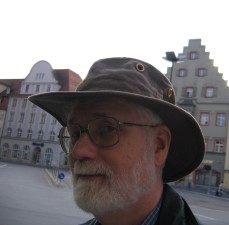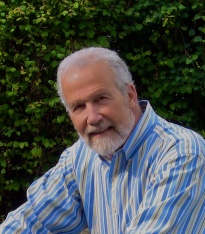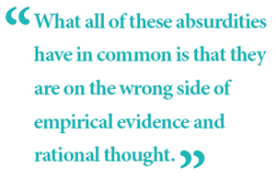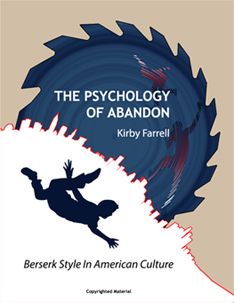
“k1f” Kirby Farrell
It was bound to happen. Protests against police killings have triggered a propaganda backlash. In the Wall Street Journal—now part of the Fox news empire—Heather MacDonald, author of Are Cops Racist?, warns that protests against police killings in cities such as Baltimore have unleashed “A New Nationwide Crime Wave.”
In a world of ads and rant screaming for attention, it makes sense to study the tools used to manipulate us. MacDonald’s argument uses what the psychology of abandon calls “berserk style.” Protests against police violence, she implies, have created a crisis, which presumably calls for emergency force to suppress protests and crime.
The psychology of abandon studies styles of thinking that disguise or rationalize behavior that is—or seems to be—out of control. In this instance, MacDonald equates demands for justice with an “onslaught” of “anti-cop rhetoric,” looting, and a “crime wave.” Protesters have run amok. But even as she inflates crime to crisis proportions, she ignores the real crisis mentality that leads hair-trigger cops to kill unarmed “suspects,” especially black “suspects.”
MacDonald’s creates her crisis out of inflammatory clichés:
This incessant drumbeat against the police has resulted in what St. Louis police chief Sam Dotson last November called the “Ferguson effect.” Cops are disengaging from discretionary enforcement activity and the “criminal element is feeling empowered,” Mr. Dotson reported. Arrests in St. Louis city and county by that point had dropped a third since the shooting of Michael Brown in August. Not surprisingly, homicides in the city surged 47% by early November and robberies in the county were up 82%. Similar “Ferguson effects” are happening across the country as officers scale back on proactive policing under the onslaught of anti-cop rhetoric. Arrests in Baltimore were down 56% in May compared with 2014.
This is the language of abandon. The “incessant drumbeat” evokes an invading army or dark-skinned jungle savages. Rather than blame protesters for a national crime wave, MacDonald alleges only that a situation “has resulted,” as if Zeus or gravity caused it. Poor blacks protest because they need to be empowered, but in the WSJ, only “the criminal element is feeling empowered.” The idea of being “empowered” is being poisoned in this negative use the way rant media have corrupted terms such as “entitlement.” Criminals are not actual people but an “element” alien as insects or atoms.
The official-sounding social science jargon clashes with the hysterical melodrama of protesters attacking police in an “onslaught.” Meanwhile the police aren’t disobeying orders, they’re “disengaging” and “scaling back” like businessmen or generals in a battle for civilization. If cops feel unhappy, MacDonald implies, they’re free to ignore orders and make their own policy. This is a vigilante fantasy.
Among cops, “proactive” enforcement is known as “broken windows” policing. It challenges indications of disorder before any actual crime can take place. If you’re black in a rough neighborhood in Philly, say, that means cops have “discretionary” power to put you down on the sidewalk and look for signs of crime. No matter how innocent you are, they can hassle, humiliate, and sometimes arrest you on phony charges.[1] The strategy sometimes works, but there is a tradeoff, sometimes a tragic tradeoff.
“Discretionary” policing takes place on the shadowy edge of the law. Police on Staten Island were being proactive when they arrested Eric Garner for selling loose (untaxed) cigarettes (July 17, 2014). He protested and they took him down, choking him to death. (Police excused.) Just as MacDonald’s polemic strips out references to actual people, so ordinary racial prejudice strips out individuality, seeing groups or stereotypes. It would be harder to kill Eric Garner if you knew him as a 43 year old father of six kids—including a 3-month infant—with a bum heart. The police knew him as a rap sheet of minor offenses: a black guy who had filed a complaint about being strip-searched on a public street.
In the WSJ op-ed, Garner is buried in unmarked numbers. Even if we try to take the statistics seriously, they’re inflammatory. How many murders does a spike of 100% entail? 2 instead of 1? 2,000 instead of 1,000? Last year US cops killed about 467 people enforcing the law, twice as many unarmed blacks as unarmed whites.[2] In Europe, the casualties are close to zero. And if statistics are so persuasive, they should reassure hair-trigger police, since according to OSHA, construction workers are 400% more likely than cops to die on the job, and police fatalities include traffic and other mishaps.
Actually it should be no surprise if crime rates spike around protests. In the 1960s when LBJ’s Great Society programs acknowledged the injustice and misery of poverty—really for the first time in US history—riots followed. In Detroit and Watts, frustrated young blacks saw that the public effort to help was indirectly an admission of past injustice, as if that justified retaliation. This is the vindictiveness of victim psychology. Feeling painfully victimized after 9/11, Americans felt justified in destroying thousands of innocent lives in Iraq, and in a war as berserk as any riot.
Police killing involves another form of abandon that’s crucial to understand. Police help maintain society in many ways. In “fighting” crime, however, they are akin to warriors, playing a heroic role by risking death. Arresting criminals is especially dangerous in the US, where gun culture has a hair trigger. Human terror of death disposes us to admire heroes whose courage can master it. It goes without saying that our need to believe in that courage disposes us to overlook or deny the survival panic in police killing.
At the bottom of society, by contrast, many blacks live on the edge of social death, some surviving through crime. Just as we inflate super-heroes, so we’re apt to exaggerate the failings of the poor, associating them with crime, laziness, brutishness, and other markers of social death. Putting down scapegoats gives self-regard a boost.
Confrontation with a poor “suspect,” then, presents two kinds of abandon. One kind is the moment when unrealistic assumptions, emergency physiology, and guns overcome judgment. The other is the danger, for the cop, of losing heroic self-esteem in a (possibly fatal) moment of panic. The cop fears death, but also the fantasy qualities he’s attributed to the “suspect.” If the suspect escapes or otherwise “wins” the contest of wills, the cop loses his heroic confidence. In officer Wilson’s fatal tangle in Ferguson, he described Michael Brown as the superhuman Hulk and himself as a helpless child. As in battle, the instant of total danger trumps inhibitions and our foundational sense of “what’s right,” triggering survival rage: berserk abandon.
“Fighting” crime, the cop feels heroic. Defying poverty and social death, the criminal feels heroic. In each case heroism offers the sensation, like a drug rush, of being a bigshot, invincibly lucky, safe from death. You don’t have to plan the moment of crisis. It can happen by chance or by “chance.” Prejudice can guide the outcome if, say, you assume that all black men are likely to be criminals. In any event, guns create their own hair-trigger mentality. To ignore this psychological dimension is as callous as it absurd:
“‘Any cop who uses his gun now has to worry about being indicted and losing his job and family,’ a New York City officer tells me.”
Hmm. What about the black guy who has to worry every day about a cop’s trigger finger? What about Eric Garner’s family?
In this regard, Heather MacDonald is a hired gun for comfortable people who read theWall Street Journal. As in Vietnam and the “war on terror,” her backlash says: Shoot first and ask questions afterward.
Do I need to add that of course not all police are killers? But even one killer can spoil your welcome home.
That’s why we need justice as well as law.
1. http://www.nytimes.com/2014/12/05/opinion/we-must-stop-police-abuse-of-b…(link is external)
http://blackagendareport.com/data_cops_more_aggressive_against_blacks_mi…(link is external)
2. The US government doesn’t publish a tally of police deaths. For useful data, see:http://www.theguardian.com/us-news/ng-interactive/2015/jun/01/the-counte…(link is external)
Also: http://www.theguardian.com/us-news/2015/jun/09/the-counted-police-killin…(link is external)
Also in this series, “Who Can You Trust?” (September 15, 2014); “The Child and the Monster” (November 29); and “Guilty Games” (December 5).
+ + + +
Source: Helena Farrell for Tacit Muse
When behavior becomes a cultural style, berserk abandon is terrifying yet also alluring. It promises access to extraordinary resources by overthrowing inhibitions. Berserk style has shaped many areas of contemporary American culture, from warfare to politics and intimate life. Focusing on post-Vietnam America and using perspectives from psychology, anthropology, and physiology, Farrell demonstrates the need to unpack the confusions in language and cultural fantasy that drive the nation’s fascination with berserk style.
“This book amazes me with its audacity, its clarity, and its scope. We usually think of ‘berserk’ behaviors—from apocalyptic rampage killings to ecstatic revels like Burning Man—as extremes of experience, outside ordinary lives. in fascinating detail, Farrell shows how contemporary culture has reframed many varieties of abandon into self-conscious strategies of sense-making and control.
Abandon has become a common lens for organizing modern experience and an often troubling resource for mobilizing and rationalizing cultural and political action.This landmark analysis both enlightens and empowers us.”
—Les Gasser, Professor of Information and Computer Science, U. of Illinois, Urbana-Champaigne.

 Mere opinions are not inherently misguided, of course. It may be my opinion that chocolate ice cream tastes better than strawberry, and even some moral opinions do not necessarily have an objective and rational basis. I can be for or against gay marriage, for example, without being asked to present any facts about the matter.
Mere opinions are not inherently misguided, of course. It may be my opinion that chocolate ice cream tastes better than strawberry, and even some moral opinions do not necessarily have an objective and rational basis. I can be for or against gay marriage, for example, without being asked to present any facts about the matter.


